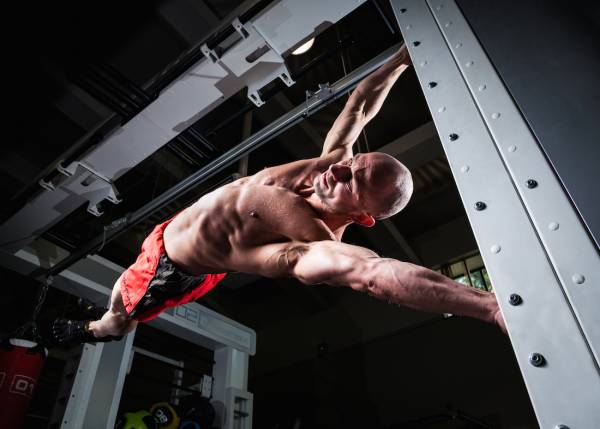In my previous article Be Your Own Expert And Turbo-Charge Your Training After Age 50, I wrote about how I’d achieved things that went against expectations for a 54 year old, things like resolving the muscle imbalances that led to my osteoarthritis diagnosis, training at an intensity and volume that would have twenty-something’s shaking in their shoes, and even sailing through menopause. I promised I’d reveal how I managed to do these things, and that starts here, but be warned: if you’re expecting to see a specific training or diet plan you’re going to be disappointed, because that’s not the key; it’s more about understanding and minimizing the influences that are trying to derail you, and making better lifestyle choices.
Exercise Is the Key
Thanks to improvements in healthcare, average lifespans are increasing and in turn, we should be seeing people holding onto youthful vigor for longer. That’s not what’s happening; if anything, the average person is hitting the skids physically at an earlier age than previous generations, and we’re even seeing diseases that used to be confined mainly to adults (like type 2 diabetes) becoming more common in children.
Research based on “baby boomers” who embraced exercise as a core part of their lifestyle, and kept going with it, is now suggesting that significant decline needn’t happen until we hit our seventies. It’s no secret: exercise is the best prescription for an enduring active life. Today’s health organizations know this, and even Hippocrates knew it well over 2000 years ago. Despite this, society and invention as a whole seem hell-bent on eliminating exercise from our lives, and though this isn’t necessarily killing us, it is making us sick.

A Driverless Vehicle with Faulty Sat-Nav
I don’t how or when it started, but our first world societies are continually broadcasting the wrong messages, sending us hurtling down the wrong tracks.
Our economies are heavily dependent on us working long hours to do things in our free time that are bad for us. We’re made to feel out of step if we don’t have more social gatherings where excess consumption of food and drink is normal, we’re sold an endless stream of labor-saving, exercise reducing gadgets, and when the effects of our inactivity start to bite we buy medicines that mask the symptoms, allowing us to carry on without tackling the real cause.
Most of our televised sports implicitly reinforce the idea that after thirty, we’re all has-beens; how often do you see an interview with an “older” athlete without hearing the question “so, when are you going to retire?”
Governments are telling us to eat less and exercise more, but their messages are largely uninspiring and certainly ineffective against the constant barrage of advertising and social pressures. Youngsters get sold all the exciting, fashionable pursuits, but what’s the message for us older types? Try to walk a bit more each day and in a few years, you might still be able to play with the grandkids without having a coronary or a stroke—please, that’s hardly the stuff to tempt people out of their comfy seats. The powers-that-be could do better, and if you’re feeling cynical you might even suspect that part of the reason they don’t is a conflict of interest; stop that over-consumption tomorrow and all our economies would instantly tank.
Set Your Own Course
To see what lies ahead if you follow society’s lead, just take a look at the average people around you who are ten, twenty, or thirty years your seniors. If you want to fare better when you reach their age, you need to do something different from them, but that’s much harder than you might think.
The first thing to realize is that many of the factors that influence our decision-making don’t operate at a purely conscious level; they slip under the radar, tapping into core traits that have been part of our makeup since humans first walked the earth. Once such influence is group or “tribal” behavior.
We are so strongly hard-wired to conform with the behavioral norms of the groups to which we feel we belong, that we’ll change our posture, mannerisms, facial expressions, the way of speaking, and even our perception and belief systems. Much of this will happen without us even realizing it. If this sounds far-fetched, Google “Asch’s Conformity” as your introduction to the power of the group.
When the social groups with which you interact are closely aligned with your fitness goals, both short term and ideally long term, they’ll aid you in achieving those goals; conversely, if your goals are in conflict with your groups, you’ll find it much harder to stick to your training and dietary plans. This shouldn’t come as any great surprise, but a less obvious implication of group conformity is that changing your group can actually change what you like and dislike. For example, if your head tells you that exercise should be a bigger part of your life but you don’t enjoy the process of exercising, then joining a group of fitness junkies is a fast way to change that.
Realizing this gives you control over a powerful tool for changing your life; you can break your ties with a group that doesn’t serve your goals, and switch to one that is a better match. I say “better” because you’ll rarely find a precise match, especially in the longer term. You’ll eventually face the hard choice again: compromise your plans, or move on. Leaving a group is never easy, but it may be necessary if you’re serious about your future.
The Marketing Monster
I’m no psychologist but even I’m aware that many of Sigmund Freud’s theories have fallen from favor. For all that, I still think his “id, ego, super-ego” model can be useful for understanding the influences around us.
The id represents the primitive, instinctual drives we all have; when it whispers in our ears, it tells us about the things it wants. Marketers forge links between these drives (typically sex, food, power, and so on) and their products. Then the id starts whispering that it wants that new car, or phone, or drink, or belly-banging meal. What’s more, marketers are very keen to spread the message that it’s okay to give in to these desires—it’s normal; it’s what everyone does. Look at these lean, fit people enjoying a life of endless partying. It’s not doing them any harm, is it?
The super-ego is the rule-driven moral conscience, whispering counter-arguments in your other ear, and stuck in the middle there’s you, the ego—the conscious mind with the power to decide what you do next. If your ego is strong, you’ll weigh the two conflicting sides and make a balanced choice that can appease both. If it’s weak, it’ll side with the id immediately then spend the next minute cooking up some pseudo-logic that justifies its decision. Have you ever opened a big pack of peanuts, and instead of taking a handful and saving the rest for another day, you’ve eaten your way through the whole thing thinking “well, if I eat them all now they’re gone, and then I can get back on the diet tomorrow?”
Marketers want you to side with your id all the time, and they’ll even provide you with some ready-made justifications so that your ego doesn’t have to work up a sweat creating its own. It doesn’t matter if some of your desires are in conflict; if the id says “I want that pizza” and “I want a six-pack,” marketers will try to sell you the pizza and one of those EMS abdominal exercisers to go with it.
There are two things to take from this concept. The first is that gaining awareness of marketing and its tricks is the first step in resisting the temptations. The second is that if marketers can create a desire within you for something that previously held no appeal, you can do that for yourself in order to serve your own goals.
Reframe Healthy to Be Enjoyable
A core technique employed by marketers is borrowed from the world of psychology: classical conditioning. Essentially this involves associating something you like with something that you don’t. It doesn’t happen instantly; it’s a cumulative effect that builds through repetition. The more you receive the message that a given thing will bring you something you really want, the more you believe it, and the two become intertwined. This is how cars and bottles of smelly liquid become associated with sex and success, this is why you want Apple’s latest iPhone, and this is how you can inject a beneficial exercise into your life and come to enjoy it.
As an example, consider how I became a fitness junkie. As a youngster I was exercise-adverse; at school, I dodged it whenever I could and was hopeless at sports. I was however interested in eastern mysticism and philosophy, and against all the odds, one evening I ended up in a beginner’s karate class. I had no interest in the physical training itself, but the overwhelmingly positive vibe that the class delivered brought me back again and again. I was surrounded by people telling me how much they enjoyed the training, and the more effort I put into each session, the more I was rewarded with feel-good endorphins to counter my sore muscles.
Eventually I didn’t even need the class environment to enjoy karate training. How can you make this work for you? Well, to build on my example, let’s say you find a personal trainer, gym, or club that delivers the training you need but sweetens the pill by making you feel good about yourself during the session. Over time, the positive associations with training will build, and in due course you won’t need the crutch that kept you going in the first place. The more you can reframe the thing you tolerate in the light of something you enjoy, the more palatable it becomes. Eventually you’ll be able to convince your id into giving you more helpful messages: “go on, just one more set, and go heavier next time.”

Rules Need to Be Broken Sometimes
For some people it’s the other side, the super-ego, that is dominant; their lives are ruled by a strong sense of duty. While this can have its benefits, particularly when it comes to steadfast compliance with a training or injury rehabilitation program, it can bring drawbacks.
People with a high level of responsibility are even more susceptible to social pressure; instead of considering their own plans for their lives, their minds are constantly invaded by thoughts of what they feel they should be doing. From a training perspective, these people are also more likely to hit long-lasting plateaus.
I have to say this is not a problem I share, but with the growth of social media I’m seeing this more and more in younger generations; they’re so dominated by the need to win the approval of their peers (Facebook likes, anyone?) that they can’t live their own lives. Just as the endless desires of the id need to be held in check, so does the anxious interruptions of an overly dominant super-ego. Not all rules have to be followed.
Decide What You Want
With all these influences around you, playing on your base desires and sense of duty, it’s crucial that you decide what goals are truly yours; only then can you confidently commit to your own path.
Start by listing the goals you currently have, and then think carefully about the motives behind each one. Do you have a genuine desire to achieve it, or have you been conditioned to want it by peer pressure and advertising? Is the goal on your list because you know it’s beneficial or practical, even though it may have little emotional appeal?
I find it useful to make a table with goals as the rows, and three columns: one for rating each goal’s desirability for yourself, one for rating desirability based on social influence (it’s fashionable or would earn you the approval of others), and one for rating its objective benefit. Goals that score highly in personal desire and objective benefit columns should float to the top of the table and be highly prioritized; if you want something and it’s beneficial to you, then you should have a stronger chance of achieving it and, more importantly, sustaining it. If something is on your list is there mostly because of the recognition it may bring you, think hard before giving it a high priority. Trying to achieve such goals may make you miserable, and even if you do succeed, it’s likely you won’t sustain it for long. Where goals are in conflict, the priority you’ve given them will break the deadlock.
Reduce the Bad Influences
When I first started writing this article, I thought I’d end up promoting high-intensity exercise and revealing how I structure my training. I do believe that high intensity is particularly important as we age, as there’s plenty of data to show that it’s our ability to perform explosively that wanes earliest and quickest. Many people struggle to sustain high-intensity training, yet I seem to thrive on it even at high frequency and volume. Why? Am I doing something differently from them?
Yes I am, but it’s not because of reps, sets, and weight. I believe I’m better able to cope with intensity and volume because I’ve greatly reduced the stress in my life. Our bodies can’t tell the difference between psychological stress and physical stress; it’s all the same. If you’re burning through your monthly stress capacity outside of the gym, you’ll have less to throw at your workouts.
The key to my stress management was to reduce the negative influences in my life by radically changing my lifestyle. Fifteen years ago I lived in the city in a house with a tiny garden and neighbors far too close for comfort. I spent 2-3 hours a day sitting in rush hour traffic and working in a well-paid job that I hated, and spent the money I earned trying to make it more tolerable. I trained extremely hard in karate for a couple of hours most evenings but spent the rest of my time stuck behind a desk or behind the wheel of a car.
Fast forward to today, and my life is far less stressful, and my work, training, and downtime are gradually moving closer and closer together. I’ve switched from the high earning job to running my own business from home; I don’t earn anything like what I did before, but being your own boss brings its own rewards. My box-like house in the city has been swapped for a home in a country village, and I count horses and cows among my neighbors. I’m a very regular gym goer, interested in calisthenics, bodybuilding, and strength training, but when the weather is good I can get my exercise outdoors. Never underestimate the training value of hammering up a mountain in the dark with a heavy pack on your back while racing to view the sunrise from the summit.

You Can Control Your Fitness Future
Instead of looking towards my 60s, 70s, and ages beyond and seeing only managed decline, I’m excited to see what shape I can be in if I take proper care of my body and keep working to identify and correct all my remaining weaknesses and imbalances.
I’m not saying my life is perfect, and it may be a long way from the kind of life you want, but it’s working far better for me than what I had before. I believe the secret is for each of us to find our own way of living rather than copy someone else’s. Your exercise choices need to be made in the context of your chosen lifestyle; it’s highly likely that you can tackle age, menopause and joint problems as well as me or even better using a very different approach. The key is to find the unique combination that works for you; you can’t buy this as a package and no one can do it for you, whatever claims they might make. Filter out the marketing messages, choose your tribes wisely, listen to your body, and follow your heart.
Ironically, I have some pretty dire events to thank for where I am now (the death of my parents and my osteoarthritis diagnosis, to name but two). These events interrupted the normal flow of my life, giving me the opportunity to see where I was being pushed and make changes. However, you can start doing this now, without needing a traumatic event to shake you out of your rut.
In my next article, I’ll share my thoughts on getting help from health and fitness professionals and also get some insight from a fitness insider, personal trainer Eric Pawlikowski.






